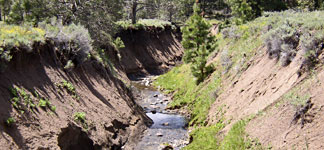Existing Conditions and Assessment Conclusions
Irrigation agriculture (primarily pasture and hay production) is the largest water user in the Pit River watershed. Approximately 230,000 acre-feet of surface water is annually diverted for this purpose. These diversions, together with the natural precipitation and stream flow patterns in this area, result in seasonal low flow (or no flow) in the Pit River and some tributaries during the summer and early fall months. This condition is in part mitigated by winter storage of wet season runoff and release of that water through the irrigation season. Seasonal low flow in many of the watercourses impacts water quality, aquatic habitat, recreation, and agricultural uses within the Pit RCD area.
In addition to variations in natural precipitation (which cannot be influenced by the management strategy), the following are factors, influence seasonal instream flow:
- Entrenched (gullied) stream channels which quickly transport wet season runoff out of the watershed, prevent high flows from accessing and rewatering meadow systems, and act as a drain on those water storing meadow systems. This condition works toward reducing dry season base flow in the River and tributary streams.
- Proliferation of undesirable and/or overly dense vegetation in the upland areas (e.g. the juniper problem) which use water that would otherwise be available in springs, wet meadows and streams.
- Inefficient transport and use of water for irrigation resulting in surface water diversions which are in excess of that actually needed for the irrigation use.
|
Pit River tributary at flood stage in January 2006. Degraded watershed conditions contribute to peak runoff from storm events causing flood damage, channel erosion, and property loss.
Pit River Dam. Water impoundment structure along Pit River used to raise water levels in the river during the summer to irrigate pastures and crops.
|
